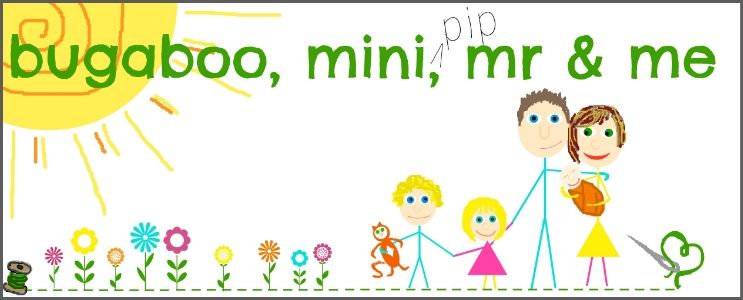I was at a complete and total loss for "just scraps." Why? I certainly have enough of them. I think I was overwhelmed by options... wood scraps? Ribbon scraps? Paper scraps? So many options! In the end, I was struck with inspiration while watching my child play with cousins. Thrilled and obsessed with the small dollhouse at Cousin's house, my daughter couldn't leave it alone. I started thinking about how useful it would be to take one along with us on short road trips or longer airplane rides... or even to the Dr.'s office or grocery store! Nothing else has caught my daughter's attention so fully and I started to wonder if my box of scrap fabrics could somehow be utilized in this project. After a bit of brainstorming, some drawings, some heat and bond mixed with the dreaded task of ironing, lots of zigzag stitches, some scraps of fabric, trim, and even elastic remnants came together to form the "Pocket Peggy House". (Not to be confused with the Polly Pocket's House, that's something entirely different...)
The Pocket Peggy House is a completely furnished, move-in ready home. It boasts the latest in modern design with stenciled walls and bold color choices. There is a lot of natural light from the open concept roofing, and the light fixtures throughout are completely updated. The curtains are both feminine and modern and add quite a lot to the decor. If you're worried about storage, never fear! There is plenty of space for all of your items in the attic! The yard is perfectly manicured and professionally landscaped with flower beds, a small garden and two window boxes. (Some of my favorite features? The pom pom valances, the spunky polka-dotted coat tree and the whale and sheet music stuffed up in the attic.) With it's funky orange doors, this home is the perfect mix of modern meets traditional meets eclectic! Don't you want to move right in? We found a family of peggies who couldn't wait - and they coordinate so nicely with their new surroundings!
What's more - the Pocket Peggy House can be rearranged and attached in any number of ways! It can stand up straight like a normal house, with the front wall opening as a door, or it can lay down flat on the ground so the Peggies can play with all of their things. It can be propped free standing with any number of walls, or it can stay completely connected to the "floor" of the house. It can be used at home, in the grocery cart, waiting for your food, or just about anywhere! Split up the walls and let each child play with their own - no fighting! And the best part is, when it's time to stop playing, the Pocket Peggy House folds up completely to be slipped - well, not QUITE into your pocket (unless you have a really big pocket) - but definitely into your purse!
***
Well, at first I really was stumped when it came to scraps. There are so many things you CAN do - the options were overwhelming. I love watching my daughter play with her cousin's doll house, though, and I thought a version just for her would be perfect. She's a little young for the tiny, intricate pieces. PLUS, we have an airplane trip coming up. With all things considered, I finally put it all together into one project -
I had so much fun with the details - and could honestly make a ton more because it was so much fun to put together.
Before you start assembling anything, you'll need to cut out squares for your walls and triangles for the roof. You can make these any size you'd like, it's totally up to you and where you want this to fit. When cutting your squares and triangles consider the following:
which pieces of scrap compliment each other the best? What color do I want the outside of my house to be? (this will be your largest scrap) What kinds of patterns do I want to include or avoid on the walls? Do I want to make an "attic" or just leave the inside of the triangles the same color as the outside?
After perusing your scraps and planning the walls and roof, you can start cutting the base pieces. You will need four squares for the outer walls, four squares for the inner walls, four triangles for the outer roofs and four triangles for the inner roofs. In addition, you will need two squares of the same color for the floor. Once all of that is done, you can move on to assembly.
1. Cut (or find) scraps that are in smallish strips and rectangles.
2. Cut heat and bond to just a bit smaller than the scrap.
3. Put the heat and bond face down and iron it onto the scrap.
4. Do this for all of the scraps you find that you want to use.
A note about "accessory" scraps: Pick a variety of colors/patterns and keep in mind what you might be using them for - florals for flowers or curtains, brown patterns for wood grains, etc. You want everything to coordinate, but it will be more interesting if it isn't all "matchy-matchy."
5. Decide on your "decor" and trace the shapes onto the heat and bond side of the scraps. I traced shapes for a door, several windows, a large bay window, small circle window for the attic, vases, curtains, table, chairs, coat rack, etc. Cut them out.
6. Design your "rooms". Lay out each inner wall piece and place your decor scraps where you want them, just to get an idea for what will go where.
7. Stack everything in order, the way you want it. Outer wall piece, outer wall piece decor, corresponding inner wall piece, inner wall piece decor... outer wall piece, outer wall piece decor, corresponding inner wall piece, inner wall piece decor... etc.
Note: The reason I found this to be so helpful was due to duplicate pieces. For instance, for every window you cut out, you will actually need two of them since the window is on the inside of the house AND the outside. I didn't want to get confused about which window went on the inside or outside, or what inside wall piece went with which outside wall piece... stacking them neatly in order with the decor pieces right on top of each really helped. I did this with the roof pieces as well, and then matched the attic pieces up with a wall piece later on.
8. Lay our your decor pieces exactly where you want them to make sure it will all fit.
9. Take the backing off of the heat and bond.
10. Lay your pieces back down where they go and iron over them to make them stick. You may have to do this one at a time.
Do this with EVERY SINGLE BASE PIECE. That's right. Every triangle. Every square. Inner, outer, floor, everything. Are you good at math? That's ironing pieces on 8 triangles and 9 squares (since there was nothing to iron to the outside of the floor. That would be weird.)
Once everything is ironed down in place, the real work begins! Start with the windows.
11. Sew down the middle of the window.
12. Turn and sew perpendicular to the previous stitch.
13. Iron on curtains around the outside of the window (if it's an interior wall piece) OR
14. Zig Zag stitch all around the outside of the window (for exterior wall pieces).
Note: You will be sewing around pretty much EVERYTHING you just ironed on. How carefully/accurately you do so, is really up to you. I suggest doing this "assembly line style" - one color of thread for every single base piece, then switch thread colors and go through each piece again. I started with black for my windows and a few other things, moved onto blue for the blue decor, then green for grass, flowers, etc, switched to orange, then pink and finished with yellow. Phew. It sounds like a lot and if you want to do it all with one thread color, well, I wouldn't blame you.
15. Sew around each decor piece. Curtains, light fixtures, grass (you can see I cheated a little on the grass), window boxes, flowers, tables, boxes, vases, etc, etc. EVERYTHING. If you don't sew it on, it will NOT withstand play.
16. As you switch thread colors, think about accessories you will want to add so you can add them at the appropriate point. For instance, when I was sewing around my green items, I added the ric rac for the stems and leaves of some of the flowers. When I was using yellow thread, I added the yellow pom pom valances, the row of daisies outside and the daisies in the vase in the attic.
Once everything is sewn, you're really almost done. It's a breeze from here.
17. Match up one triangle to each square piece - interior to interior and exterior to exterior. Place the bottom of the triangle to the top of the square, right sides together, and pin.
18. Use a straight stitch to sew them together.
19. Do this for every square/triangle combo.
20. Lay out your wall/roof piece. See how the seam looks yucky?
21. Iron the seam flat.
22. Iron the rest of the piece while you're at it. Doesn't it look so much nicer, now?
23. Now, match up the exterior pieces to the interior counterparts. Place them right sides together.
24. Take a small bit of elastic (I used leftover hair band pieces) and sandwich it in a loop on either side of the walls (you can see the orange bits sticking out below.) Pin all the way around.
25. Start at the bottom corner - where the bottom meets the side - and sew up the wall, around the roof and down the other wall. DO NOT SEW THE BOTTOM.
26. Leave the bottom open.
27. Sew each outside wall to it's matching inside wall in the same fashion.
28. Turn them right side out and iron them flat again. I know it seems like a lot of ironing, which I detest, but it really does look so much better and make things easier.
A note: You will also need to sew your inside floor to the outside floor. Do this the same way as the walls - right sides together - and sandwich elastic pieces in THREE sides. Leave the fourth side OPEN.
29. Get your plastic canvas out. Lay your pieces down.
30. Trance around your pieces.
31. Cut them out. There should be five pieces total.
32. Slide each plastic piece inside its exact wall to make sure it will fit exactly. Trim as needed.
33. Lay your plastic piece on a piece of batting. I know. You can't see the plastic piece. Trust me, it's there. It's on the right, down in the corner... no? Well...
34. Wrap the plastic in the batting and trim to the right shape.
35. Slide the batting wrapped plastic canvas piece inside the wall through the opening at the bottom.
36. Do this with all five pieces.
37. All you have left to do is sew up the openings! Just fold the edges into the inside and top stitch across each bottom.
I don't have a picture of this step, but then you'll want to hand sew on your buttons. Each outer wall will have three buttons - sew the buttons right next to where the elastic is coming out on either side, and in the middle on the bottom.
And then you really ARE done! Yea!
Now you can button the walls together in any order you'd like.
To collapse the house and tote it around, just start with it laying flat, fold in the outer two wall pieces, then fold back in the middle so those pieces are now the top and bottom. Place the floor piece inside the top wall. Pull the elastics from the bottom piece over the buttons on the top piece to keep it all together.
I need to make a cute bag for the peggies...
And now you have a portable little dollhouse that you can play with in a number of different ways!
Thank you so much for voting and reading through this tutorial! It sounds like a lot of work, I know, but I'm really glad I finished it. It gets a lot of use between the kids around this place!

*Be sure to check the right sidebar for all the fun parties I link to!
























































1 comment:
THis is awesome Kimberly! Very very cool. You are such a great mom. :)
Post a Comment